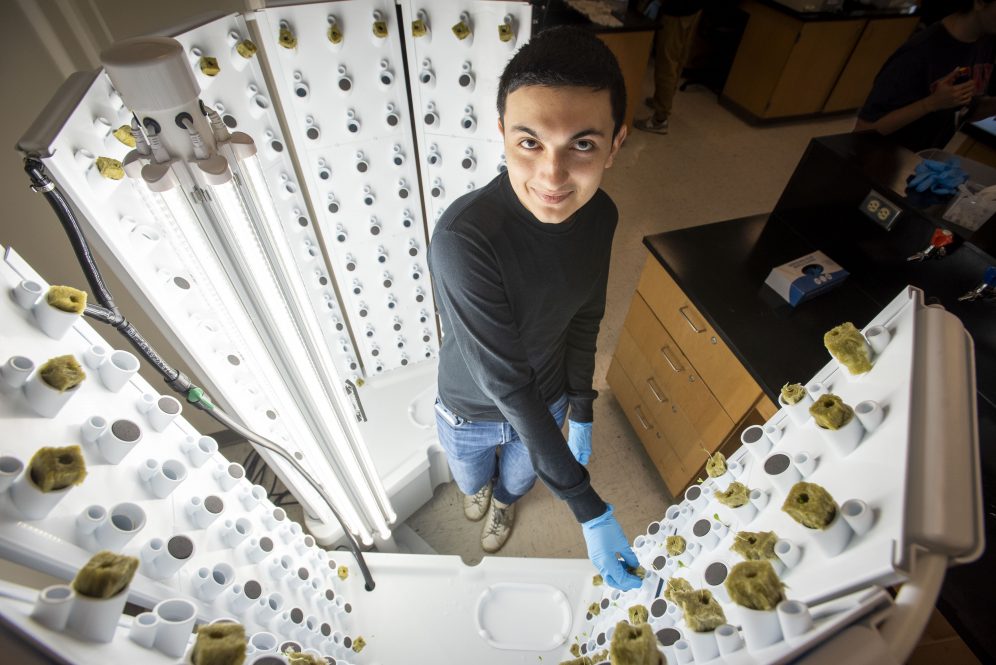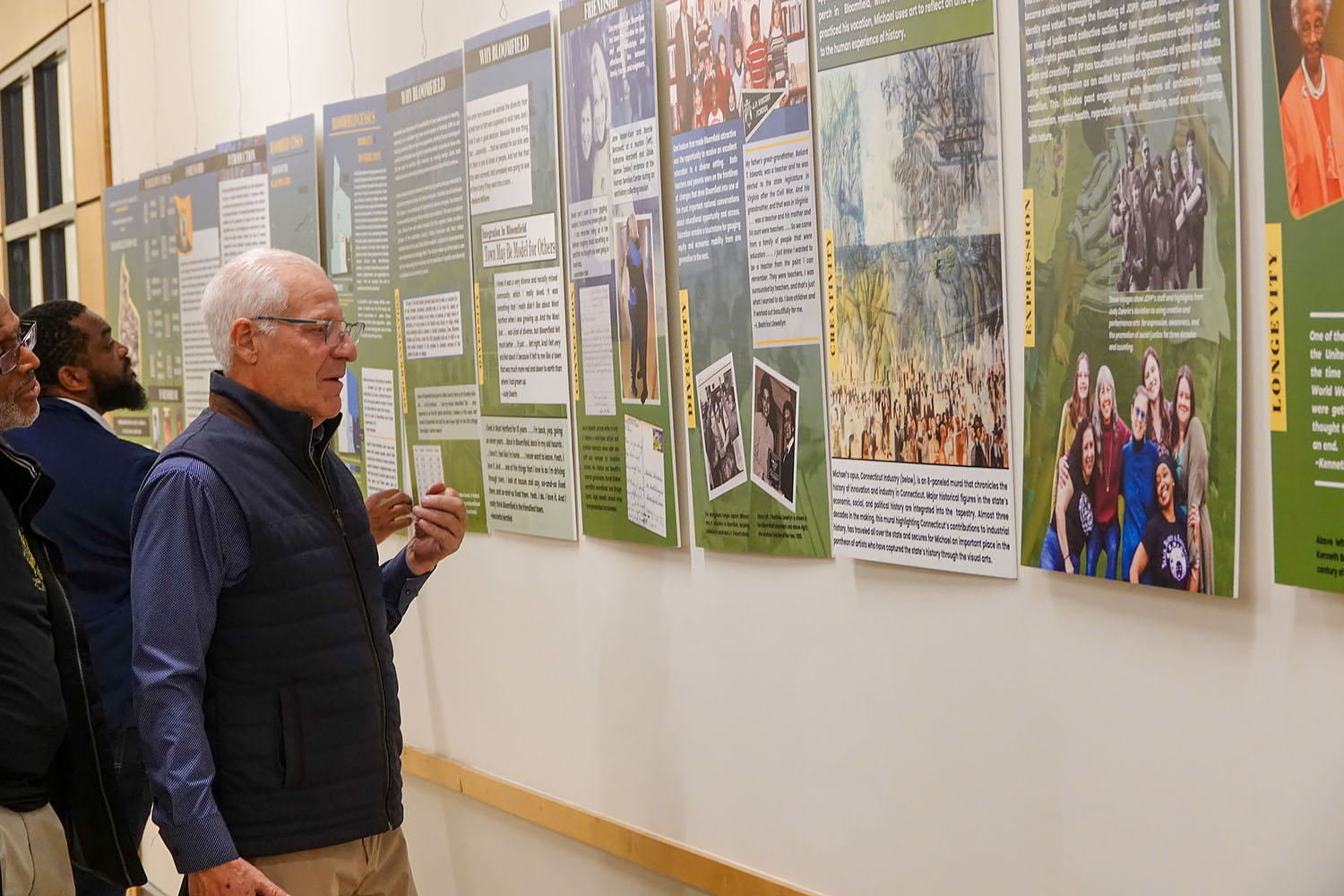Karlie Krasowski ’27 (CLAS) learned the importance of helping others by watching the actions of her great-grandmother.
Every Tuesday for 40 years, the now 93-year-old volunteered to distribute bags of food at her local pantry, teaching Krasowski both that there’s no stigma in asking for help and that, if one’s able, they should be on the giving end.
When the time came early this year for Krasowski and friend Tiarra Shaw ’27 (NUR) to fulfill the latter part of great-grandma’s message, they knew they were doing right by her.
Their ongoing project, “Foundations for Success: Bridging Home and Campus Life,” is funded by a Spring 2024 Change Grant through the UConn Co-op Legacy Fellowship Program and provides kitchen essentials to UConn Stamford students.
Because having a can of soup in the cupboard is all well and good, as long as you own a can opener.
“Providing students with cooking essentials is just as important as providing them food. Kitchen items like pots and pans, strainers, knives, and utensils are expensive, and you need them to be able to make your own food, whether you buy things from the store or get them from a pantry,” Krasowski says.
Students at UConn Stamford don’t have access to a traditional college dining hall. Instead, the meal plan partners with nearby restaurants to offer meals at commercial establishments. Students buy a block of meals at a time – say, four blocks of 25 for a total of 100 – which equates to about one meal a day in a single semester.
But students’ class schedules can be erratic, especially if they’re figuring in studying and working, and oftentimes don’t jibe with business hours. Dorms at UConn Stamford include kitchens though, giving students the ability to cook for themselves.
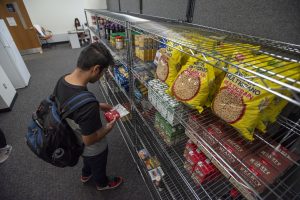
“I didn’t bring a lot of things last year because I didn’t have that much money,” Shaw says of outfitting her dorm kitchen. “There was a lot that I had to get from this project, like measuring spoons, cutting boards, and storage containers.
“I have always felt the want and need to help others,” she continues. “Growing up, I participated in food and clothing pantries, soup kitchens, and even campus ministry at school. So, being a part of this project means so much to me because giving back is something I’ve always wanted to make a priority.”
Sociology associate professor-in-residence Laura Bunyan, who serves as mentor to Krasowski and Shaw on their project, has been saying since spring 2022 when one of her classes hosted a pop-up pantry at UConn Stamford, a precursor to the University-wide Husky Harvest food pantry initiative that took off later that year, that students need to be able to cook the food they take home.
Turning a box of macaroni and cheese into a meal requires a pot to boil the water, strainer to drain the noodles, knife to cut the butter, measuring cup to measure the milk, spoon to stir it together, and a utensil to eat it with. Portioning it into two meals and taking one on the go requires a microwave-safe storage container.
“We’re trying to tie together everything we’re doing to fight food insecurity at UConn Stamford. All our initiatives need to support one another,” says Bunyan.
And there’s lots happening at the regional campus – even as the kitchen essentials distribution continues this year.
New location, new refrigerator, new hydroponic farm, new collaboration
Husky Harvest Stamford has moved locations from the lower level of campus to the second floor, in a bigger space, Bunyan says. The new room has an adjacent storage area and enough square footage to allow for an arrangement of shelves and tables to give it a grocery store feel.
Funding from the City of Stamford 2024 Community Microgrant Program has allowed for the purchase of a new refrigerator, one with see-through glass doors to allow pantry patrons to easily check what perishables might be on hand.
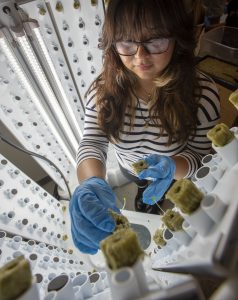
“A lot of times, we would have yogurt in our more traditional-looking refrigerator, but students were too polite and wouldn’t open the door. This will allow people to see what’s in there and help us track inventory,” Bunyan explains.
Offering produce, which like yogurt also needs refrigeration, is something Husky Harvest Stamford hasn’t been able to do in large quantities because, as for any pantry, finding a supplier is challenging.
But in yet another new initiative this year, Stamford will take a stab growing its own.
Bunyan credits her research assistant, Victoria Almazan ’26 (SSW), with obtaining an Environmental and Social Sustainability Grant from UConn’s Office of Sustainability within the Institute of the Environment to purchase an indoor hydroponic system, known as a Flex Farm. The indoor vertical farm, when working at its maximum, can grow more than 394 pounds of produce annually.
Right now, the plan is to grow mostly lettuce and microgreens with the help of the Stamford biology department, Bunyan notes, although other vegetables might come later in the year. The first of the produce could be available in about a month.
Bunyan says the idea came from a group of students in one of her classes, in which everyone splits into teams to conceive innovative projects to support Husky Harvest Stamford. In February, one group pitched the idea for a living wall of edible plants or produce, and, by the end of the semester, grant approval had come through.
“This will be a total game changer in terms of promoting healthier eating,” Bunyan says. “We want to feed students, yes, but we also want to get them more nutritionally minded foods and options.”
Other class projects have included the creation of QR codes for the pantry shelves to scan for quick, easy recipes and a partnership with a local church that resulted in the donation of a supply of kitchen tools.
Stop & Shop has been a longtime supporter of the pantry, last year providing $7,500 in gift cards for pantry workers to use to purchase items they needed but couldn’t get elsewhere. This year, Husky Harvest Stamford will receive $10,000 in an outright donation, giving pantry workers even more flexibility.
“This is huge, especially with the size of the campus student body growing. We have more students than ever and that just means more students who will need crucial things like food,” Bunyan says, referencing the 2,600 undergraduate students on campus this year, up 400 from 2023-24.
In yet another significant venture is a collaboration with the Norwalk-based nonprofit, Filling in the Blanks, which has delivered more than 3 million meals to children in Fairfield and Westchester (New York) counties since 2013.
Bunyan says the school-based program allows students – preschool to high school and now college – to take home a bag of groceries so they can eat on weekends. UConn Stamford students will have to qualify for the program upon application.
“We’ve assembled a really great team of people who work together very well and are always looking to make these ideas come to reality and support our students to give them more of what they deserve and what they really need,” Bunyan says.
‘Budget Bites’ teaches students how to cook with Husky Harvest ingredients
“The other thing we need now is salad dressing,” she continues. “Students are going to take home this fresh, farm-grown lettuce and what are they going to do with it without dressing?”
Enter Lori Gresham, an assistant professor-in-residence in the psychological sciences department.
“I am a very passionate salad dressing person,” Gresham says candidly. “I love salad dressing, and I have a huge box of different salad dressing recipes that don’t have the additives of bottled dressings. Take a can of tomatoes, for instance, if you drain the juice, you can make a tomato vinaigrette that is delicious.”
About a year ago, Gresham says she happened to walk into Husky Harvest Stamford and found herself excited by the variety of products on the shelves. From canned beans to pasta, she says she thought about all the recipes she could come up with based on what was on hand.
“Then I looked at the shelves from a student perspective, and there was canned soups and peanut butter and jelly and those kinds of things. But I wondered if there wasn’t some kind of gap for our students where they didn’t take items home with them because they didn’t know how to put them together to make a meal,” she says.
Gresham says she started cooking at 11 years old and delighted in teaching her now-grown four children how to maneuver seamlessly in the kitchen. So, she asked Jennifer Orlikoff, campus dean and chief administrative officer, for permission to teach students simple meals that could be made in their dorms or at home.
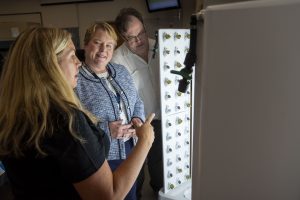
She started by recruiting two students to survey their peers on what they needed. Do they cook? Do they want to learn to cook? Do they know how to put together ingredients?
“What we found is that a lot of students didn’t even know we had Husky Harvest. The survey also reiterated what we already know – that a lot of students struggle with food insecurity. About 40% of respondents said they go without at least one meal and up to five per month,” she says.
Last summer, she started filming a few how-to videos: What goes into minestrone soup, how to make white rice. Then she added filmed instructions on how to make cinnamon roll pancakes, homemade chicken nuggets with canned chicken, pomodoro sauce and spaghetti – all developed with ingredients from Husky Harvest Stamford.
An on-campus contest named the project “Budget Bites,” and Gresham opened an Instagram account – @uconnstamford_budget-bites – to give the videos a home.
Then, twice last year, she advertised a live cooking class done via Webex. Upon signing up, students received a bag of ingredients and supplies from Husky Harvest Stamford.
For overnight oats, they got oatmeal, a mason jar, and enough extra ingredients to make the recipe several times. For baked ziti, students received the requisite cheese, noodles, and sauce, along with a baking pan and likely leftovers for a week.
With spots for 15 students in each class, Gresham props the camera in her home kitchen and shows them exactly what to do, step by step. With the help of technology, they cook together. Two more, one in each semester, are being planned for this year.
“Cooking is my passion. I love teaching psychology, it doesn’t feel like work to me, but cooking is my hobby and with all my children off to college or with their own families, there’s no one to sit in the kitchen with me and teach things to. Now I get that outlet,” she says.
Using pantry ingredients like black beans, tomatoes, canned chicken, and canned corn, Gresham last semester challenged herself to make two meals and one snack.
The result? Enchilada casserole, chips and salsa, and taco soup – recipes still available on the Instagram account, along with directions for things like spaghetti aglio e olio and chapati bread, dishes many young adults might struggle to pronounce, yet now can make on their own.
“I try to keep in mind the knowledge of cooking and level of difficulty with each recipe. I like fast meals for the students because I would rather them cook something at home that takes five minutes to prepare and 20 minutes to cook, than be tempted to just grab fast food,” she says.
